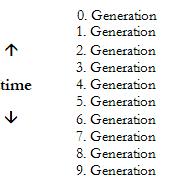

A cellular
Automaton (CA) is an amount of cells, each have a defined, almost
discrete state (initial state). A rule, which considers the cell state
and the state of defined neighbour cells, determines the cell
state of the next generation.The cells may arranged in a line
(1-dimensional), in a plain (2-dimensional) or higher dimensions.
One of the most famous CA is the Game of Life by John Conway from the 1970ies. It's 2-dimensional.
But with GeZA
you can explore CA only in one dimension, just one
line. The second dimension will show here the temporal lapse. This
means that
the ongoing generations are arranged from the top to the bottom. For
example here the rule 0100, resp. 01 (missing digits GeZA interprets as
0).


|
sum from the 3 neighbor cells (left, middle, right) |
0 |
1 |
2 |
3 |
|
state of the (middle) cell in the next generation |
0 |
1 |
0 |
0 |
This rule is left/right symetric. The CAs which rules depends only on the sum of the neighbours are called "totalistic".
| character |
function |
| = |
the cell keeps the state. |
| + |
state of the cell is incremented by 1, 9 goes to 0. |
| - |
state of the cell is decremented by 1, 0 stays 0 |
| ! |
0 goes to 1, otherwise the state is 0. |
| ? |
the cell gets a random state (0..9) |
| > |
the cell gets the highest state from neighbours. |
| < |
the cell gets the lowest state from neighbours. |